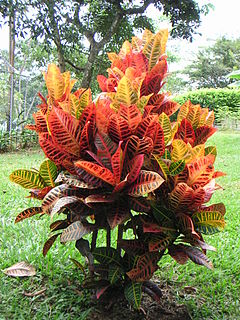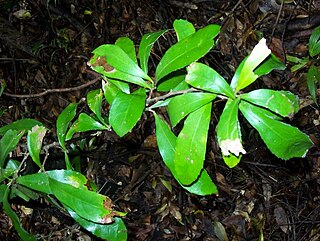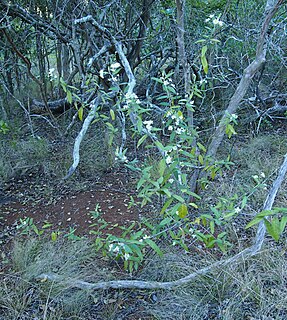
Codiaeum variegatum is a species of plant in the genus Codiaeum, which is a member of the family Euphorbiaceae. It was described by Carl Linnaeus in 1753. It is native to Indonesia, Malaysia, Australia, and the western Pacific Ocean islands, growing in open forests and scrub.

Cryptocarya triplinervis is a rainforest tree growing in eastern Australia. Common names include the three veined laurel, three veined cryptocarya and the brown laurel.

Croton verreauxii known as the green native cascarilla is a small tree or shrub growing in dry rainforest and rainforest margins in eastern Australia.

Cissus hypoglauca is a common Australian vine. It is one of the better known climbing plants of the genus Cissus in the grape family. A very common climber in moist areas of eastern Australia, it often colonises large areas after forest damage due to storms, fire or logging. Common names include jungle grape, water vine, giant water vine, five-leaf water vine, jungle vine, native grapes and billangai.

Helicia glabriflora is a species of rainforest shrubs or small trees occurring in eastern Australia. Common names include smooth or pale helicia, pale, leather or brown oak. They grow naturally in a variety of different rainforest types from the Illawarra, New South Wales to the Townsville area, Queensland. Of all the global diversity of approximately one hundred Helicia species, this one species naturally grows the furthest south, in the Minnamurra Rainforest and the Robertson area, Illawarra, New South Wales, there observed more on the relatively fertile basalt and alluvial soils.

Fontainea australis is a rare rainforest plant from eastern Australia. The common name is southern fontainea. It grows in sub tropical rainforest at low altitudes on basaltic alluvial soils. Distributed from the Wilsons River to the Tallebudgera Valley in south eastern Queensland.

Acronychia laevis, commonly known as hard aspen, glossy acronychia or northern white lilly pilly, is a species of shrub or small tree in the citrus family, and is endemic to eastern Australia. It has simple, elliptical to egg-shaped leaves, groups of creamy white flowers and fleshy, mitre-shaped to spherical fruit.

Hedraianthera is a genus of a sole recognised species of shrubs or small trees endemic to Australia from the family Celastraceae.

Alphitonia petriei, known as the white ash, is a rainforest tree in the family Rhamnaceae. It grows in eastern and northern Australia. Other common names include red ash, white-leaf, pink almond and pink ash. It was originally collected from the Johnston River near Kuranda, and named in 1925 by K.W. Braid. The authors gave it the species name petriei after W.R. Petrie, who alerted them to its distinctness.

Pittosporum spinescens is a shrub native to woodlands and dry rainforest of Northern and Eastern Australia and New Guinea. Growing to 7m tall with small leaves clustered on short branches that often terminate in a sharp point. The plant produced edible fruits, 2–3 cm in diameter. It is commonly known as wallaby apple, orange thorn or thorn orange. P. spinescens is very similar in appearance to the closely related Pittosporum multiflorum, but is readily distinguished by its entire leaf margins, in contrast to the toothed leaf margins of the latter.

Acalypha eremorum is a species of shrubs of the plant family Euphorbiaceae, endemic to Queensland, Australia. Commonly known as soft acalypha, turkey bush or native acalypha. The species grows as an open branched shrub to 2 m tall with small leaves with crenate margins. Plants may shed their leaves in response to prolonged drought. Branches often end in spines, especially on smaller plants. Small flowers are produced in spikes throughout the year and are followed by deeply lobed capsular fruit.

Olearia canescens is a shrub belonging to the family Asteraceae. Commonly known as Grey Olearia, Grey Daisy Bush or New England Daisy Bush, the species is endemic to Eastern Australia, growing in monsoon forests and drier rainforest types from North Queensland to northern New South Wales. O. canescens can grow as a woody shrub up to 6 metres in height, an unusual habit for a member of the daisy family. However it more commonly exists as a low shrub of 2 – 4 metres with only a slightly woody form.

Exocarpos latifolius is a species of parasitic trees, of the plant family Santalaceae. They have the common names broad leaved ballart, scrub sandal-wood, scrub cherry, oringorin, broad leaved cherry or native cherry. The species is found in monsoon forest, littoral rainforest and occasionally in more open forest types in Malesia and across Northern Australia.

Ehretia saligna, commonly known as peach bush, native willow and peachwood is a species of shrubs or small trees, endemic to Northern Australia. The natural range extends from the Gascoyne, across the Northern Territory throughout northern Queensland and coastal; regions of Southern Queensland and New South Wales.

Clematicissus opaca, called small-leaf grape, pepper vine, small-leaved water vine, yaloone and wappo wappo, is a small vine endemic to Australia. Pepper vine is naturally found in rocky locales in monsoon forest, littoral rainforest and open forest, and is occasionally grown as a garden plant. The plant is primarily restricted to coastal and sub-coastal regions in Queensland and New South Wales, although it does occur inland, west of the Great Dividing Range, in central New South Wales,
Hollandaea is a genus of four species known to science, of Australian rainforest trees, constituting part of the plant family Proteaceae.
Brassiantha hedraiantheroides is a species of Australian understory shrubs or small trees, constituting part of the plant family Celastraceae. In 2012 botanist Andrew J. Ford formally scientifically named and described them as the first recognised Australian species of the genus Brassiantha. Previously several publications provided informal scientific descriptions of this species under the provisional names "Hedraianthera sp. Mossman Qld Herbarium" or "Hedraianthera sp. Mossman".

Aceratium is a genus of about 20 species of trees and shrubs of eastern Malesia and Australasia from the family Elaeocarpaceae. In Australia they are commonly known as carabeens. They grow naturally in rainforests, as large shrubs to understorey trees and large trees.
Helicia nortoniana, also named Norton's silky oak, is a species of rainforest trees, of northeastern Queensland, Australia, from the flowering plant family Proteaceae.

Australian Tropical Rainforest Plants, also known as RFK, is an identification key giving details—including images, taxonomy, descriptions, range, habitat, and other information—of almost all species of flowering plants found in tropical rainforests of Australia, with the exception of most orchids which are treated in a separate key called Australian Tropical Rainforest Orchids. A key for ferns is under development. RFK is a project initiated by the Australian botanist Bernie Hyland.

















